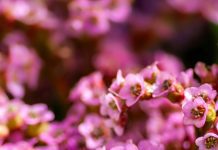For many years the City of Calgary has been encouraging us to compost our vegetative matter by selling black plastic composters in the spring. Compost is nutrient-rich humus that is the end product of plant material breakdown. Calgary’s heavy clay soil contains little plant material and compost lightens the soil, helps it hold oxygen and moisture, and adds valuable nutrients. If you allow leaves to remain undisturbed for a year or two, Mother Nature will do the job herself. We gardeners are far too impatient to wait for this, so we compost. Of the many ways to build compost, this simple one is my favorite:
Recipe for Compost
- Brown Material
- Green Material
- Soil
- Water
Method: Locate your compost container in a sunny location, out of sight, and easy to access. (If you can’t get to it, you won’t use it.) Pile in a bunch of brown material (dry leaves, straw, wood chips, sawdust, paper, dryer lint, vacuum fluff, etc.) You need way more brown stuff than green stuff so be generous. Add a layer of green (kitchen peels, coffee grounds, tea leaves, anything fruit or vegetable, weeds, grass clippings). Throw on a couple of shovels of garden soil. This will be teeming with lots of helpful critters like bacteria, fungi, and earthworms. Add some water from the rain barrel (tap water will work but chlorine slows down the process a bit) to make it damp like a sponge. Now add more layers of everything until the container is full. Put on the lid and let it work.
Hints: Small pieces decompose faster than big ones. Chop if you are in a hurry.
Stir it up occasionally, or at the very least poke holes with the proddy-thing tool you bought with the composter. Moisture and oxygen must be available right down to the bottom for the process to work. Add more brown and green and soil as you work in your garden and as the pile shrinks. Keep damp, but not too wet.
In Calgary’s short growing season, the compost you start in the spring will be ready the following spring. One started in the fall will be ready to mulch on the beds the following fall. If you have two containers, you can have compost all year round. Keep a bucket of some sort under the kitchen sink and add clippings and peels to the composter as it fills up. I always bag some fall leaves to use the next summer and have been known to beg leaves from my neighbours when my trees were little.
Compost Tea is simply a bag of compost steeped for a few days in a garbage can of water. If you use city tap water, let it sit for a couple of days first for the chlorine to evaporate before adding the compost. Stir occasionally. In a few days you will have a lovely organic tea full of nutrients your plants will love. Filtered and in a spray bottle, you can mist the leaves; unfiltered, put on the ground around the roots. This is perfect in the spring to give your babies a boost, and throughout the early summer (diluted) to keep them healthy. Remember, though, that the tea will likely be high in nitrogen which stimulates leaf growth. If you are looking for fruit and flowers, you may wish to discontinue mid-July.









